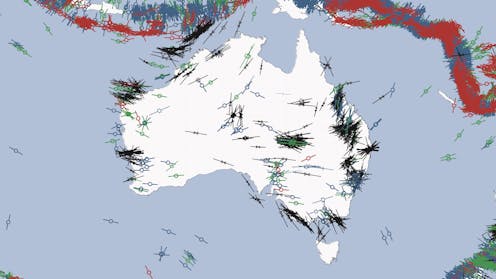Why does Australia have earthquakes? The whole continent is under stress from distant forces
- Written by The Conversation

Last Saturday at 9:49am local time, a magnitude 5.6 earthquake occurred about 50km west of Gympie in Queensland. The earthquake was experienced as strong shaking locally, but did not produce any significant damage, likely because of the remote location of the epicentre.
However, the quake was felt far and wide and small aftershocks continue. More than 24,000 people across eastern Australia reported it, not only in the nearest big city (Brisbane) but as far away as Cairns and Sydney. This was the largest earthquake in onshore southeast Queensland since 1935, when an earthquake of magnitude 5.5 occurred near Gayndah.
Most of the world’s earthquake hotspots are near the boundaries between tectonic plates – places such as New Zealand, Japan and Indonesia. Here, earthquakes are frequent because of the immense forces where two plates collide or slide past one another.
But Australia sits in the middle of the Australian tectonic plate, far from any plate edges. So why do earthquakes still happen here?
Tectonically ‘quiet’ – but not silent
Australia is often seen as tectonically “quiet” and stable.
But this picture is only partly true. As Saturday’s seismic event shows, earthquakes do happen here, and Australia has a rich record of recent faults and seismic activity.
On average, Australia has an earthquake larger than magnitude 6.0 about once every seven years, and one greater than magnitude 5.0 roughly once a year. Geological studies of recent faults tell us that Australia could host an earthquake up to around magnitude 7.5.
What drives earthquakes in Australia?
Even though Australia is far from the edges of tectonic plates, the continent is still being squeezed and stressed by the large forces at those distant plate boundaries. These stresses travel deep into the plate and build up.
When the stress becomes too great, it is suddenly released along zones of weakness in the crust (known as fault zones). That release is what we feel as an earthquake.
The map below shows just how widespread earthquakes and active faults are across the continent.
The Australian stress field
Over the past four decades, scientists have built up a detailed picture of the stresses acting in the Australian crust. This comes from many sources including earthquake information, borehole data, mining sites, and large-scale engineering projects.
The results have been compiled in two projects: the Australian Stress Map and the World Stress Map. These show Australia’s stress patterns are highly variable and different from those of other continents.
Unlike some continents, where the direction of maximum horizontal stress tends to line up neatly with the movement of plates, Australia’s stresses twist and turn, changing direction across the country. Large-scale computer modeling shows this can be explained by the combined effect of tectonic forces at the edges of the Indo-Australian Plate.
Stress and earthquakes in Queensland
The recent earthquake occurred near Kilkivan, west of Gympie, in an area where many faults are aligned in a northwest–southeast direction. One of the most important of these is the North Pine Fault System, a wide zone made of many separate fault segments.
This network of fractures tells a long geological story of movement, stretching back millions of years, that has shaped the landscape of eastern Australia. Geoscientists believe the fault system is quite ancient – between around 50 million and 250 million years old.
However, there have been numerous modern earthquakes in the surrounding region, which suggests the fault system may still be active. The area has experienced several significant earthquakes in the past, including events in 1883, 1918, 1935 and more recently, 2015.
The maximum stress in this region is directed from northeast to southwest. The driving forces come from far beyond Australia.
The Australian tectonic plate is compressed from the north and east by the Pacific plate, particularly along boundaries near the New Hebrides, the Solomon Islands, and the Tonga–Kermadec zone which stretches from New Zealand to Tonga. This compression reaches deep into Queensland.
It is these forces from distant plate boundaries that are behind Australian earthquakes like the recent one in Kilkivan, even though we are far from the world’s active plate edges.
Since Saturday morning’s earthquake, more than 15 aftershocks have been recorded. Most have been quite small, with magnitudes less than 2.0. A main shock of the moderate magnitude experienced near Gympie will typically produce an aftershock as large as magnitude 4.5, in addition to the many more smaller events.
So, as the crust adjusts to the changes in local stress produced by this earthquake, seismic activity is expected to continue for days or weeks, but with overall smaller and less frequent earthquakes as time goes on.







